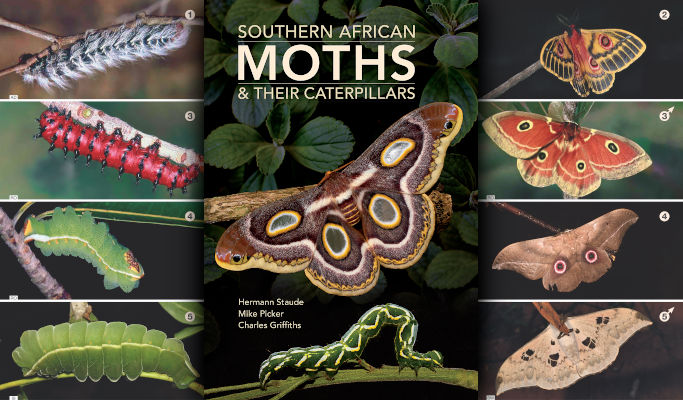Crawling marvels and winged wonders – the making of Southern African Moths and their Caterpillars
More about the book!

Hermann Staude, Mike Picker and Charles Griffiths describe the craftsmanship involved in creating their guide Southern African Moths and their Caterpillars.
‘More than 270 000 distribution records were within reach for the book and are now available for future conservation projects.’
Producing a field guide that adequately covers a megadiverse group of animals like moths (Lepidoptera), depicting them as they naturally occur in the wild and telling their story takes thousands of hours of dedication, involving many people.
There are well over 11 000 species of moths described from the southern African subcontinent, with hundreds more awaiting formal description, and with many species new to science still regularly being discovered. It is estimated that the actual diversity of southern African moths is probably well over 20 000 species. Unlike humans who spend most of their lives as adults, moths spend most of their lives as caterpillars. Their ecological impact is primarily as caterpillars and therefore, to tell their story, one also needs to consider the caterpillars and what they do.
It was at the 2011 conference of LepSoc Africa, held at Kirstenbosch, Cape Town, when Hermann gave a presentation on southern African moths photographed in the wild, that the audience encouraged him to consider the possibility of a field guide on moths, depicting them as they appear in the wild and not as museum specimens. He made an appointment to see Pippa Parker at Struik who encouraged him to pursue this project further.
A project like this, depicting the vast moth fauna with images of live specimens, has not been attempted before and relied on a considerable body of resources accumulated over the years. It became clear that although he already had thousands of images and location data, there were also large gaps and very little known about the caterpillars.
To fill these gaps, Hermann embarked on monthly expeditions to set up moth-attracting tents as part of a light trap, that allowed moths to settle naturally on the vegetation for photography. These tents were set up at 1 272 major habitats.
To address the paucity of knowledge on caterpillars, in 2012 Hermann launched ‘The Great Moth Caterpillar-hunt Challenge’, which lead to the formation of the now well-established Caterpillar Rearing Group (CRG). In the decade that followed, the CRG has increased our knowledge on the region’s caterpillars from less than seven percent of the known species to over 32 percent.
Occurrence data is not only important to produce accurate species distribution maps, but also to provide evidence of habitat preferences. Hermann’s records were databased. In partnership with the South African Lepidoptera Conservation Assessment project (SALCA), two people were employed by him for four years to capture and label data in the Ditsong Museum of Natural History, Pretoria, and the South African Museum, Cape Town. iNaturalist and Lepimap provided valuable additional locality data and the authors added thousands of further data points during the production of the book. In the end, more than 270 000 distribution records were within reach for the book and are now available for future conservation projects.
Identification of species, especially for those in little-known families, has always been a challenge. To address this issue, voucher specimens were collected by Hermann after photography, prepared, preserved and sent to taxon specialists across the world for further study and identification. This process not only ensured accurate identifications but also culminated in the formal description of many new species. In fact, many of the photographed individuals featured in the book eventually became type specimens now housed in various museums.
Charles and Mike were independently interested, after their very successful Field Guide to the Insects of South Africa, to write a field guide on the moths of South Africa. They contacted Hermann and in 2019 the authors decided to join forces and pool resources.
Charles, with all his experience in writing such books, drafted a detailed plan for the project. Given the huge number of species in the subregion, the authors decided on a plan of which species to include for each moth family, to ensure that the entire fauna is adequately covered.
Charles and Mike researched the available published literature for the selected species and wrote a first draft of the text. Hermann then added further information based on available unpublished resources and added more species where needed. Taxon specialists across the world were then sent parts of the manuscript for peer review.
People often say that books are so expensive nowadays, but this is not true. For the price of less than what it costs for a modest evening out for two, you can get the results of more than a decade of research. The book is unique – providing the only recent and substantive guide to southern African moths and their caterpillars. It is hoped that it will be widely used and provide naturalists with a resource that will enable them to appreciate the fascinating world of moths.
Southern African Moths and their Caterpillars is out now.
~~~
This article was originally published in The Penguin Post, a magazine about books for book lovers from Penguin Random House South Africa.
Categories Lifestyle Non-fiction South Africa
Tags Charles Griffiths Hermann Staude Mike Picker Nature Penguin Random House SA Southern African Moths and their Caterpillars The Penguin Post
